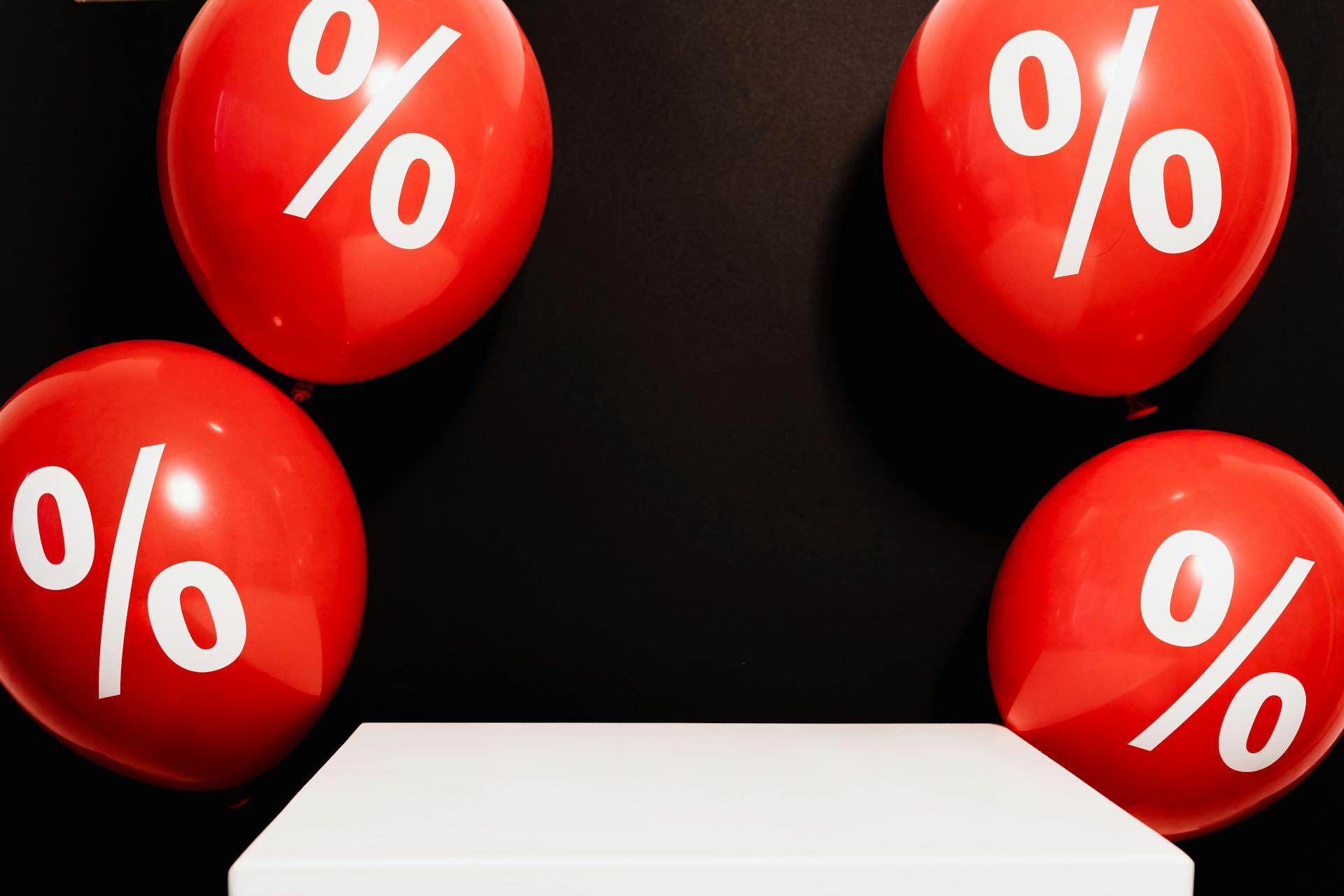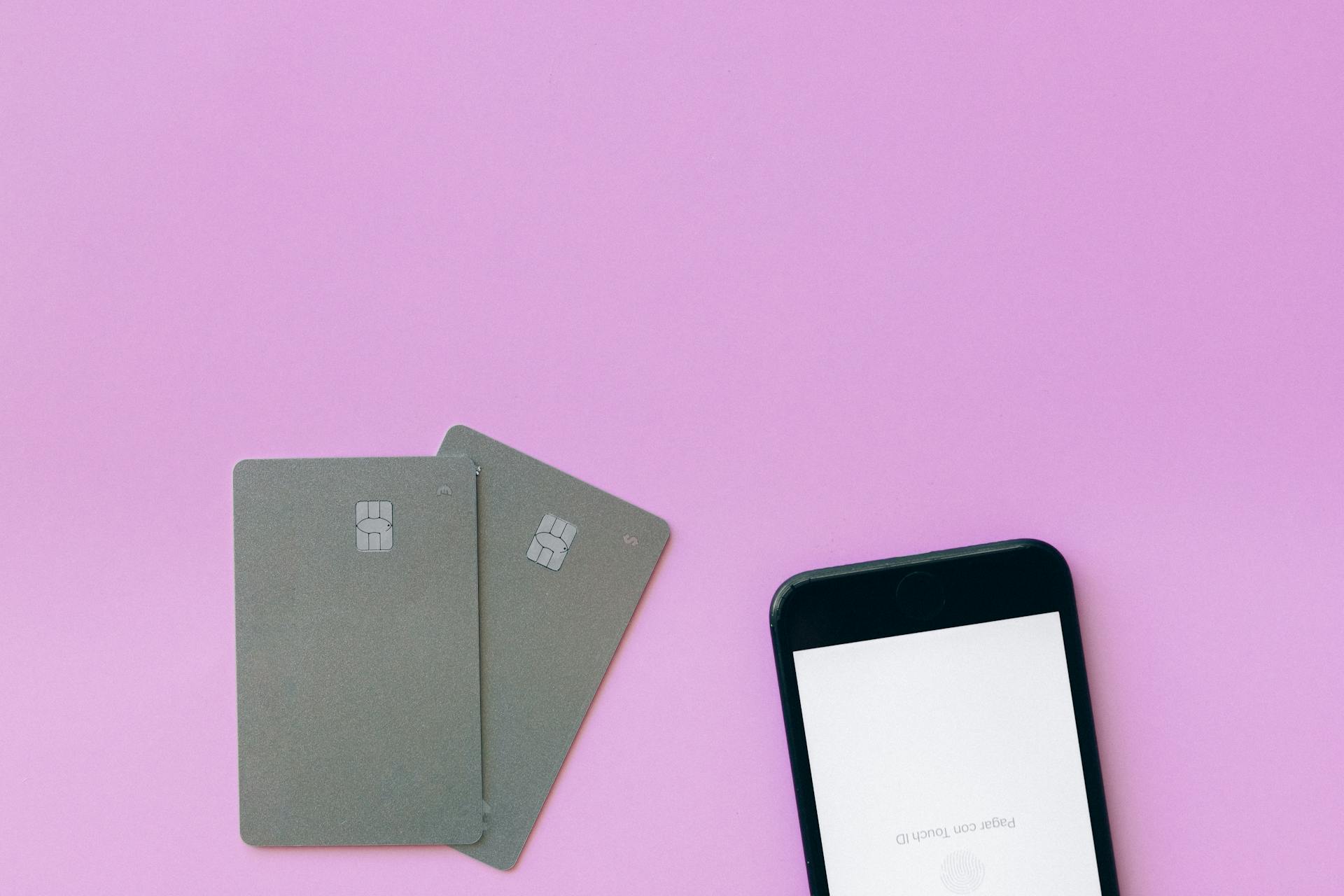
Keeping your credit card utilization ratio below 30% is a good rule of thumb for maintaining a healthy credit score.
This means that if you have a credit limit of $1,000, you should try to keep your balance below $300.
Keeping your credit utilization ratio too high can negatively impact your credit score, making it harder to get approved for loans or credit cards in the future.
A credit utilization ratio of 30% or less shows lenders that you can manage your debt responsibly.
For your interest: Laws about Keeping Credit Card Numbers on File
Understanding Credit Card Usage
Your credit card utilization rate is a crucial indicator of lending risk, with lenders viewing people who constantly charge all they can as more likely to have difficulty repaying.
Managing credit utilization effectively isn't just about reducing debt, but also being aware of how and when you use your credit.
To keep your credit score in check, consider the following strategies: make credit card payments more than once a month, spread your charges across multiple cards each month, and increase your available credit.
Take a look at this: Making Multiple Credit Card Payments in One Month
Paying off a portion or all of your credit card bill before the credit card issuer reports your credit activity to the credit bureaus can lower your credit utilization.
Using multiple cards will result in multiple accounts of low credit utilization, but be aware that certain credit-scoring models may look at your overall credit utilization.
If your income has increased or you've maintained a great credit history, it's worth asking for a credit limit increase, but be aware that this can result in a hard inquiry on your credit.
For your interest: Is Having Multiple Credit Cards Bad
Calculating and Managing Credit Card Usage
Calculating and managing your credit card usage is a crucial step in maintaining a healthy credit score.
To calculate your credit utilization ratio, you'll need to divide your balance by your credit limit. For example, having a $500 balance on a card with a $5,000 credit limit would give you a 10% credit utilization rate on that card.
Here's an interesting read: Is Credit Utilization Based on All Cards
Your overall credit utilization ratio is calculated by adding up all your revolving credit account balances and dividing the total by the sum of your credit limits. You can use the formula: [(Credit Card 1 Balance) + (Credit Card Balance 2 or Other Revolving Credit Line Balance), etc.] / [(Card 1 Credit Limit) + (Card 2 Credit Limit or Other Revolving Credit Line’s Limit), etc.]
A good credit utilization ratio is generally considered to be below 30%. Keeping your balance below 30% of your total available credit shows lenders that you're responsible and not over-relying on credit.
Here's a simple breakdown of what different utilization ratios might mean:
Remember, the lower your credit utilization ratio, the better. Aim to keep it below 30% to show lenders you're responsible and can manage your credit effectively.
Best Practices for Credit Card Usage
Your credit utilization ratio is a simple calculation of how much credit you're using compared to how much is available to you. It's one of the key factors lenders look at when assessing your creditworthiness.
Ideally, you want to aim for a utilization rate of 30% or lower to keep your credit score in good shape. Lower is even better.
Using nearly 100% of your credit limit, like Joe does, isn't doing him any favors. It's not destroying his credit, but it's not giving him any financial breathing room either.
Aim to keep your credit utilization ratio in the single digits for an excellent credit score. This will give you more financial flexibility and a better shot at future credit approvals.
You don't have to be like Joe and use nearly all of your credit limit. By keeping your utilization ratio low, you'll be in a stronger financial position and have more opportunities for future credit.
Check this out: Keep Getting Denied for Credit Cards
Car Loan Approval: What You Need to Know
When applying for a car loan, lenders look beyond your credit score and check your credit utilization. This means they want to know how much of your available credit you're using, and it can impact your loan approval.

Lenders consider your credit utilization ratio, which is the amount of credit you're using compared to your available credit limit. For example, if you have a credit card with a $1,000 limit and you've charged $500, your credit utilization ratio is 50%.
A high credit utilization ratio can negatively impact your loan approval, as lenders view it as a sign of financial instability. This is because it may indicate you're relying too heavily on credit and struggling to manage your debt.
To improve your chances of car loan approval, aim to keep your credit utilization ratio below 30%. This shows lenders you can manage your debt responsibly and are less of a risk.
Credit Score and Credit Card Usage
Your credit score is closely tied to your credit card usage, making up about 30% of your total score. This is because lenders want to see that you're responsible with the credit they're offering you.
To keep your credit score in good shape, it's essential to keep your credit utilization ratio low. This is the percentage of your available credit that you're actually using, and it's recommended to aim for a utilization rate of 30% or lower. Using 50% or more of your available credit, like carrying a balance of $500 on a $1,000 credit card, can be considered high by lenders.
High utilization on a single credit card can be especially damaging to your credit score if you have a short credit history and only one card. However, if you have a long and excellent credit history and spread your utilization across multiple cards, you may feel the effects less.
If this caught your attention, see: Can You Keep Credit Cards in Chapter 13
Why Does Data Matter?
Data matters because it helps you understand how your credit card usage affects your credit utilization ratio.
A lower credit utilization ratio suggests you're managing your available credit wisely, which can work favorably for you when applying for a loan or new credit card.
Credit reporting agencies use your credit utilization ratio as a barometer of your ability to manage credit, also known as your creditworthiness.
How Does My Card Affect Credit Scores?
Your credit card utilization can significantly impact your credit scores, making up about 30% of your total score. This is because lenders view a high credit utilization ratio as a sign of increased lending risk.
A person who constantly charges all the money they can is more likely to have difficulty repaying that money, which can negatively affect their credit scores. This is why it's essential to keep your credit utilization ratio in check.
If you have a short credit history and only one credit card, high utilization on that single card can especially hurt your credit scores. On the other hand, spreading your utilization across multiple cards can reduce the impact.
You want to aim for a utilization rate of 30% or lower to keep your credit score in good shape, and lower is even better. Many people with excellent credit scores keep their utilization in the single digits.
Keeping a low credit utilization ratio across your credit cards is a top priority because it heavily influences your credit score. In fact, the amount you owe compared to your available credit makes up about 30 percent of your score according to both major credit scoring models.
Check this out: Can I Add More Money to My Secured Credit Card
Lowering Credit Card Usage
Using no more than 30% of your credit limit at any given time can help prevent a temporary dip in your credit score. This is a good rule of thumb to keep in mind when making purchases with your credit card.
Paying down your balance multiple times per month can also help keep your credit score lower, despite a higher overall monthly credit utilization. This is because your credit card issuer will typically report your credit activity to the credit bureaus once a month, so paying off a portion or all of your credit card bill before that date can lower your credit utilization.
To lower your credit card utilization, consider making credit card payments more than once a month. This can help prevent your balance from getting too high and make it easier to keep your credit utilization ratio low.
Here are some additional tips to help you lower your credit card utilization:
- Make payments more than once a month to lower your credit utilization.
- Spread your charges across multiple cards each month, but be aware that certain credit-scoring models may still consider your overall credit utilization.
- Increase your available credit by asking for a credit limit increase or opening a secured credit card, but be aware that this can result in a hard inquiry on your credit.
Remember, paying off your balance quickly and often can help keep your credit utilization ratio low and prevent a temporary dip in your credit score.
Credit Card Metrics and Rates
Traditional wisdom suggests that keeping credit utilization below 30% is beneficial for credit scores.
The lower your credit utilization ratio, the better it is for your credit score. The higher the ratio, the worse the negative impact on your credit score.
Your credit utilization ratio is a percentage that shows how much of your available credit you're currently using.
To calculate your credit utilization ratio, you need to know your available credit and your current balance. For example, if you have a credit card with a $1,000 limit and a balance of $300, your credit utilization ratio is 30%.
Here are some general guidelines for credit utilization ratios:
You can lower your credit utilization ratio by making payments more than once a month, spreading charges across multiple cards, or increasing your available credit.
Frequently Asked Questions
What happens if I use 90% of my credit card?
Using 90% of your credit card's limit can negatively impact your credit utilization ratio, but having multiple cards with lower utilization can help maintain a good credit score. This is a key factor to consider when managing your credit card usage.
Sources
- https://www.chase.com/personal/credit-cards/education/basics/how-much-credit-utilization-is-considered-good
- https://www.firstalliancecu.com/blog/how-much-of-your-credit-card-should-you-use
- https://www.forbes.com/advisor/credit-cards/how-much-of-my-credit-card-limit-should-i-use/
- https://www.bankrate.com/credit-cards/tools/credit-utilization-calculator/
- https://www.creditkarma.com/credit-cards/i/credit-card-utilization-and-your-credit-score
Featured Images: pexels.com


